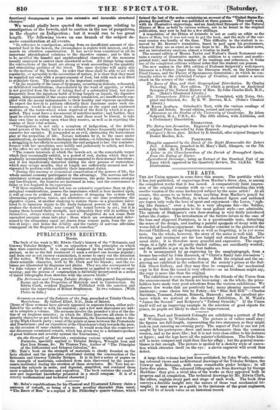THE ARTS.
Tau Art Union appears in some force this season. The portfolio which it has just published, of engravings from Maclise's Seven Ages, is among the completest works that it has issued. A comparatively faint impres- sion of the original remains with us—or are we conforinding this -with another version of the same hackneyed subject by the same artist? At all events, this seems to us better than anything from Madise's pencil for many a day. The Schoolboy, in whose slackened figure and saddened eye regret only veils the love of sport and enjoyment—the Lover, "sigh- ing like furnace," over a lute, to a very adequate fair—the Soldier,' seeking the bubble reputation in the most gallant style—are admirable. The episode of Shalrspere's own deer-stealing is very fairly introduced before the Justice. The introduction of the furtive lovers in the case of the lean and slippered Pantaloon, is in a questionable taste, disturbing the sense of the design, and loading a painful speatacle of decay with the worse foil of heedless enjoyment: the similar contrast in the picture of the, Second Childhood, old age forgotten as well as forgetting, isin yet worse taste. On the whole, however, the story of the series is well told. The
i drawg and treatment are far less turgid and strained than MacEsh's usual style ; it is therefore more graceful and expressive. The engra- vings, in a light style of gently shaded outline, are excellently worked; and the portfolio is got up in the best fashion.
It is accompanied by an engraving by the anaglyptograph, from a bronze bas-relief by John Hancock, of "Christ's Entry into Jerusalem"; a graceful and not inexpressive design. Both the original and the en- graving are exhibited in the collection of the society's prizes at the Suf- folk Street Gallery, and they may thus be compared : the meolmaierd copy in flat from the round is very effective—as an Irishman might sayr the copy is more like than the original.
The exhibition is even more gratifying to the friends of the Union than the announcement that its funds are increasing : on the whole, the prize- holders have made very good selections from the various exhibitions. We observe few works that are positively bad ; many pleasing specimens of landscape; some choice bits by Fahey—his "Blue Bell 4111"—Charles Davidson, Tennant, Janus; Bennett, Hancock; and the excellent pic- tures which we noticed at the Academy Exhibition, E. M. Ward's "James the Second" and Redgrave's "Patient Griselde." If the Union. itself will set an improving example in the selection of good objects for, prizes, its pupils are likely to share the improvement.


























 Previous page
Previous page